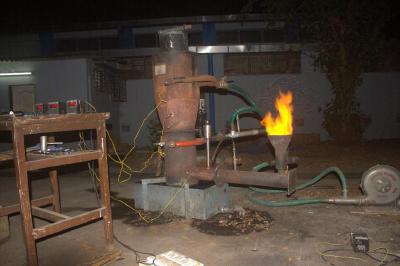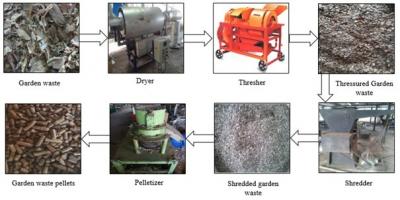

Municipal solid waste is not a severe problem in rural areas but in urban areas there is not enough land available to allow it to degrade on its own. The waste such as garden waste has low density (75-100 kg/m3 ) and hence occupies a lot of space in landfills, and is difficult to compost due to high ash content of leaves. The incineration option is better but expensive to build, operate and maintain in developing countries as the moisture content is high in wastes. On the other hand, gasification provides more control over thermochemical conversion of biomass feedstock and generates producer gas (syngas) with calorific value in the range of 4-6 MJ/kg. Moreover one can build small scale gasifiers to utilise the energy produced. Proper segregation and collection of waste followed by appropriate treatment would contribute for various applications such as composting, cooking and power generation. Hence, pelletisation followed by gasification, is proposed as a potential solution to densify solid waste and generates producer gas not only to manage waste problem but also to generate energy and assist LPG based cooking. Gasifiers are usually feed specific and hence multiple problems arise when used for other feed.
The Tata Centre for Technology and Design (TCTD) at IIT Bombay has come up with a new design of gasifier that would be able to process multiple feedstock (different combinations of different types of municipal solid wastes) with improved efficiency and end-user adaptability. The team focussed efforts on managing garden waste generated at a magnitude of 2-3 tonnes/day inside IIT Bombay campus. The stages before gasification include waste collection, shredding, drying, removal of sand and gravels, finally followed by pelletisation (refer Fig. 1). The feedstock-specific operating parameters (like particle size, moisture and ash content, etc.) for garden waste pelletisation are identified and pellets are successfully made at the rate of 50 kg/hr. The fixed bed downdraft gasifier [modified TERI gasifier (Fig. 2)] gave producer gas with typical calorific value of 3.67 MJ/kg and cold gas efficiency of 55 % when operated on garden-waste pellets (ash content 10 %) at equivalence ratio of 0.33. The variation of different operating parameters such as air flowrate, solid flowrate and air distribution is studied to recommend optimum operating conditions.
Major problem experienced in initial experiments was formation of clinker due to melting of ash thus blocking the grate and ash removal. Different possibilities of preventing and minimising clinker formation were explored. The increase in ash removal rate by frequent grate movement and supply of air throughout the cross-section of gasifier instead of two peripheral points near combustion zone reduced the clinker formation by more than 90 %.
Considering the limitations of existing gasifier in terms of performance and operational issues, we developed a new patented design for the gasifier that runs on high ash feedstock such as garden waste. The performance of this gasifier has been tested and analysed at IIT Bombay campus in laboratory. Few cooking trials have also been conducted on the gasifier to get feedback from professional cook in terms of equipment usage.
The proposed gasifier based cookstove along with the pelletisation facility is going to have huge market potential, as it is coming up with two major benefits of solving the garden waste management issue and reducing the dependence on LPG for community cooking application. Since the gasifier would be designed to operate on pellets made from municipal solid waste (e.g. garden waste), which is a very poor quality biomass, it could also be used for other feedstocks such as coal, wood and agro residue. Hence, this technology will not only benefit urban areas with respect to waste management and reduced LPG consumption in community cooking, but also benefit users of combustion based cookstoves in terms of improved emissions.
Apart from community level cooking, gasification of pellets could be the source of energy to numerous small-scale rural and cottage industries. The system developed is expected to pay back the capital cost of equipment within a year for cooking application.
In India, to start with, these gasifiers could be installed in campuses similar to IIT Bombay, industrial townships, newly established colonies with proper waste collection, religious tourist places with mass level cooking, etc. The proposed technology would result in reduced deforestation through fuel wood savings in addition to substantial reduction in fossil-fuel based generated LPG consumption. This would also save the land required for landfills and composting to manage municipal solid waste.
Prof. S Mahajani
